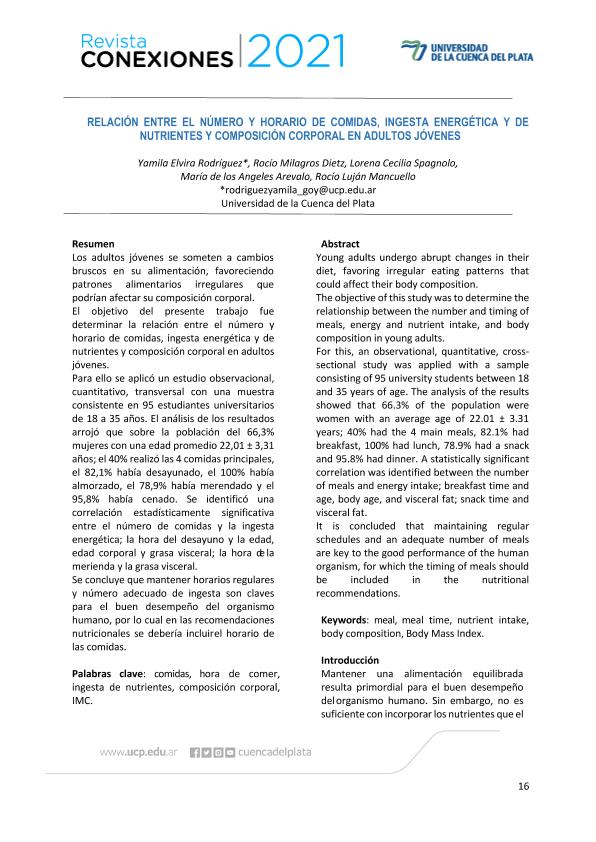Artículo
Los adultos jóvenes se someten a cambios bruscos en su alimentación, favoreciendo patrones alimentarios irregulares que podrían afectar su composición corporal. El objetivo del presente trabajo fue determinar la relación entre el número y horario de comidas, ingesta energética y denutrientes y composición corporal en adultos jóvenes. Para ello se aplicó un estudio observacional,cuantitativo, transversal con una muestra consistente en 95 estudiantes universitarios de 18 a 35 años. El análisis de los resultados arrojó que sobre la población del 66,3% mujeres con una edad promedio 22,01 ± 3,31 años; el 40% realizó las 4 comidas principales, el 82,1% había desayunado, el 100% había almorzado, el 78,9% había merendado y el 95,8% había cenado. Se identificó una correlación estadísticamente significativa entre el número de comidas y la ingesta energética; la hora del desayuno y la edad, edad corporal y grasa visceral; la hora de la merienda y la grasa visceral. Se concluye que mantener horarios regulares y número adecuado de ingesta son clavespara el buen desempeño del organismo humano, por lo cual en las recomendaciones nutricionales se debería incluirel horario de las comidas. Young adults undergo abrupt changes in their diet, favoring irregular eating patterns that could affect their body composition. The objective of this study was to determine the relationship between the number and timing of meals, energy and nutrient intake, and body composition in young adults. For this, an observational, quantitative, crosssectional study was applied with a sample consisting of 95 university students between 18 and 35 years of age. The analysis of the results showed that 66.3% of the population were women with an average age of 22.01 ± 3.31 years; 40% had the 4 main meals, 82.1% had breakfast, 100% had lunch, 78.9% had a snack and 95.8% had dinner. A statistically significant correlation was identified between the number of meals and energy intake; breakfast time and age, body age, and visceral fat; snack time and visceral fat. It is concluded that maintaining regular schedules and an adequate number of meals are key to the good performance of the human organism, for which the timing of meals should be included in the nutritional recommendations.
Relación entre el número y horario de comidas, ingesta energética y de nutrientes y composición corporal en adultos jóvenes
Rodríguez, Yamila Elvira; Dietz, Rocio Milagros ; Spagnolo, Lorena Cecilia
; Spagnolo, Lorena Cecilia ; Arevalo, María de los Angeles; Mancuello, Rocío Luján
; Arevalo, María de los Angeles; Mancuello, Rocío Luján
 ; Spagnolo, Lorena Cecilia
; Spagnolo, Lorena Cecilia ; Arevalo, María de los Angeles; Mancuello, Rocío Luján
; Arevalo, María de los Angeles; Mancuello, Rocío Luján
Fecha de publicación:
29/07/2022
Editorial:
Universidad de la Cuenca del Plata
Revista:
Conexiones
ISSN:
2591-3344
Idioma:
Español
Tipo de recurso:
Artículo publicado
Clasificación temática:
Resumen
Archivos asociados
Licencia
Identificadores
Colecciones
Articulos(IQUIBA-NEA)
Articulos de INSTITUTO DE QUIMICA BASICA Y APLICADA DEL NORDESTE ARGENTINO
Articulos de INSTITUTO DE QUIMICA BASICA Y APLICADA DEL NORDESTE ARGENTINO
Citación
Rodríguez, Yamila Elvira; Dietz, Rocio Milagros; Spagnolo, Lorena Cecilia; Arevalo, María de los Angeles; Mancuello, Rocío Luján; Relación entre el número y horario de comidas, ingesta energética y de nutrientes y composición corporal en adultos jóvenes; Universidad de la Cuenca del Plata; Conexiones; 1; 7; 29-7-2022; 16-28
Compartir



